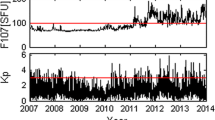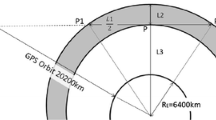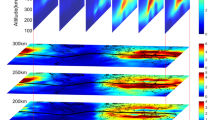Abstract
We report on the FormoSat-3/Constellation Observing System for Meteorology, Ionosphere and Climate (FS3/COSMIC) limb-viewing observations of GPS L-band scintillations since mid-2006 and propose to study global F-layer irregularity morphology. The FS3/COSMIC has generally performed more than 1000 ionospheric radio occultation (RO) observations per day. We reprocess 1-Hz amplitude data and obtain complete limb-viewing profiles of the undersampling (sampling frequency lower than Fresnel frequency) S4 scintillation index from about 80% of the RO observations. There are a few percent of FS3/COSMIC RO observations having greater than 0.09 undersampling S4max values on average. However, seven identified areas, Central Pacific Area (−20° to 20° dip latitude, 160°E–130°W), South American Area (−20° to 20° dip latitude, 100°W–30°W), African Area (−20° to 20° dip latitude, 30°W–50°E), European Area (30°–55°N, 0°–55°E), Japan Sea Area (35°–55°N, 120°–150°E), Arctic Area (>65° dip latitude), and Antarctic Area (<−65° dip latitude), have been designated to have a much higher percentage of strong limb-viewing L-band scintillations. During the years in most of the last sunspot cycle from mid-2006 to the end 2014, the scintillation climatology, namely, its variations with each identified area, season, local time, magnetic activity, and solar activity, have been documented.









Similar content being viewed by others

References
Aarons J (1982) Global morphology of ionospheric scintillations. Proc IEEE 70:360–378. doi:10.1109/PROC.1982.12314
Basu S, Basu Sa (1985) Equatorial scintillations: advances since ISEA-6. J Atmos Terr Phys 47:753–768. doi:10.1016/0021-9169(85)90052-2
Basu S, MacKenzie E, Basu S (1988) Ionospheric constraints on VHF/UHF communications links during solar maximum and minimum periods. Radio Sci 23(3):363–378
Basu S et al (1996) Scintillations, plasma drifts, and neutral winds in equatorial ionosphere after sunset. J Geophys Res 101:26795–26809. doi:10.1029/96JA00760
Basu S, Groves KM, Basu S, Sultan PJ (2002) Specification and forecasting of scintillations in communication/navigation links: current status and future plans. J Atmos Sol Terr Phys 64:1745–1754. doi:10.1016/S1364-6826(02)00124-4
Brahmanandam PS, Uma G, Liu JY, Chu YH, Latha Devi NSMP, Kakinami Y (2012) Global S4 index variations observed using FORMOSAT-3/COSMIC GPS RO technique during a solar minimum year. J Geophys Res 117:A09322. doi:10.1029/2012JA017966
Carter BA, Zhang K, Norman R, Kumar VV, Kumar S (2013) On the occurrence of equatorial F-region irregularities during solar minimum using radio occultation measurements. J Geophys Res 118:892–904. doi:10.1002/jgra.50089
Coker C, Hunsucker R, Lott G (1995) Detection of auroral activity using GPS satellites. Geophys Res Lett 22:3259–3262. doi:10.1029/95GL03091
Dymond KF (2012) Global observations of L band scintillation at solar minimum made by COSMIC. Radio Sci 47:RS0L18. doi:10.1029/2011RS004931
Evans JV, Holt JM, Wand RH (1983) A differential-Doppler study of travelling ionospheric disturbances from Millstone Hill. Radio Sci 18:435–451. doi:10.1029/RS018i003p00435
Gorbunov ME, Gurvich AS, Shmakov AV (2002) Back-propagation and radio-holographic methods for investigation of sporadic ionospheric E-layers from Microlab-1 data. J Remote Sens, Int. doi:10.1080/01431160010030091
Hajj GA, Lee LC, Pi X, Romans LJ, Schreiner WS, Straus PR, Wang C (2000) COSMIC GPS ionospheric sensing and space weather. Terr Atmos Ocean Sci 11(1):235–272
Hei MA, Heelis RA, McClure JP (2005) Seasonal and longitudinal variation of large-scale topside equatorial plasma depletions. J Geophys Res 110:A12315. doi:10.1029/2005JA011153
Hocke K, Tsuda T (2001) Gravity waves and ionospheric irregularities over tropical convection zones observed by GPS/MET radio occultation. Geophys Res Lett 28(14):2815–2818. doi:10.1029/2001GL013076
Ishimaru A (1978) Wave propagation and scattering in random media. Academic Press, New York
Kelley MC (2009) The earth ionosphere: plasma physics and electrodynamics, 2nd edn. Elsevier, Amsterdam
Ko CP, Yeh HC (2010) COSMIC/FORMOSAT-3 observations of equatorial F region irregularities in the SAA longitude sector. J Geophys Res 115:A11309. doi:10.1029/2010JA015618
Kursinski ER, Hajj GA, Schofield JT, Linfield RP, Hardy KR (1997) Observing Earth’s atmosphere with radio occultation measurements using the Global Positioning System. J Geophys Res 102:23429–23465. doi:10.1029/97JD01569
Makela JJ, Kelley MC, Sojka JJ, Pi X, Mannucci AJ (2001) GPS normalization of and preliminary modeling results of total electron content during a midlatitude space weather event. Radio Sci 36(2):351–361. doi:10.1029/1999RS002427
Ott E (1978) Theory of Rayleigh–Taylor bubbles in the equatorial ionosphere. J Geophys Res 83(A5):2066–2070. doi:10.1029/JA083iA05p02066
Rino CL (2011) The theory of scintillation with applications in remote sensing. Wiley, Hoboken
Rocken C, Kuo Y-H, Schreiner W, Hunt D, Sokolovskiy S, McCormick C (2000) COSMIC system description. Terr Atmos Ocean Sci 11(1):21–52
Schreiner WS, Sokolovskiy SV, Rocken C, Hunt DC (1999) Analysis and validation of GPS/MET radio occultation data in the ionosphere. Radio Sci 34(4):949–966. doi:10.1029/1999RS900034
Singleton DG (1974) Power spectra of ionospheric scintillations. J Atmos Terr Phys 36:113–133. doi:10.1016/0021-9169(74)90071-3
Sokolovskiy SV (2000) Inversions of radio occultation amplitude data. Radio Sci 35(1):97–105. doi:10.1029/1999RS002203
Su S-Y, Chung-Lung W, Liu C-H (2014) Correlation between the global occurrences of ionospheric irregularities and deep atmospheric convective clouds in the intertropical convergence zone (ITCZ). Earth Planets Space 66:134–141. doi:10.1186/1880-5981-66-134
Sultan PJ (1996) Linear theory and modelling of the Rayleigh–Taylor instability leading to the occurrence of equatorial spread-F. J Geophys Res 101(26):875. doi:10.1186/1880-5981-66-134
Syndergaard S (2006) COSMIC S4 data, from the website: http://cdaac-www.cosmic.ucar.edu/cdaac/doc/documents/s4_description.pdf
Tsai L-C, Kevin Chang K, Liu CH (2011) GPS radio occultation measurements on ionospheric electron density from low Earth orbit. J Geodesy. doi:10.1007/s00190-011-0476-9
Uma G, Liu JY, Chen SP, Sun YY, Brahmanandam PS, Lin CH (2012) A comparison of the equatorial spread F derived by the International Reference Ionosphere and the S4 index observed by FORMOSAT-3/COSMIC during the solar minimum period of 2007–2009. Earth Planets Space 64:467–471. doi:10.5047/eps.2011.10.014
Vorob’ev VV, Gurvich AS, Kan V, Sokolovskiy SV, Fedorova OV, Shmakov AV (1999) Structure of the ionosphere based on radio occultation data from GPS “Microlab-1” satellites: preliminary results. Earth Obs Remote Sens 15:609–622
Ware R, Exner M, Feng D, Gorbunov M, Hardy K, Melbourne W, Rocken C, Schreiner W, Sokolovsky S, Solheim F, Zou X, Anthes AR, Businger S, Trenberth K (1996) GPS soundings of the atmosphere from low earth orbit: preliminary results. Bull Am Meteor Soc 77:19–40
Weber EJ, Klobuchar JA, Buchau J, Carlson HC Jr, Livingston RC, de la Beaujardiere O, McCready M, Moore JG, Bishop GJ (1986) Polar cap F-layer patches: structure and dynamics. J Geophys Res 91:12121–12129. doi:10.1029/JA091iA11p12121
Yeh KC, Liu CH (1982) Radio wave scintillations in the ionosphere. Proc IEEE 70:324–360. doi:10.1109/PROC.1982.12313
Acknowledgements
The work was supported in part by MOST 104-2111-E-008-027-MY3 from the Ministry of Science and Technology, Taiwan, R.O.C., and in part by a grant from the Asian Office of Aerospace Research and Development (AOARD) of the US Air Force Office of Scientific Research (AFOSR) (AOARD-13-4126). The authors would also like to thank UCAR’s CDAAC and NSPO Satellite Operations Control Center (SOCC) for providing FS3/COSMIC satellites data.
Author information
Authors and Affiliations
Corresponding author
Rights and permissions
About this article
Cite this article
Tsai, LC., Su, SY. & Liu, CH. Global morphology of ionospheric F-layer scintillations using FS3/COSMIC GPS radio occultation data. GPS Solut 21, 1037–1048 (2017). https://doi.org/10.1007/s10291-016-0591-4
Received:
Accepted:
Published:
Issue Date:
DOI: https://doi.org/10.1007/s10291-016-0591-4



